We hope that each of you, our readers, will enjoy and appreciate this article we present about these 4 Awesome Arthropods of Africa. It was certainly our pleasure to compile the information for you. May it provide you with both education and increased awareness.
These few species listed herein represent only a portion of the natural wonders found throughout the region, though. Yet, it’s our belief that they serve as excellent representations of the wonders found here. Check out some of our other articles for similar marvels.
Signature Spider
Signature Spider Facts
- Beginning this article about these 4 Awesome Arthropds of Africa is the creation of evolution that creates unique patterns in its web, the Signature Spider.
- The commonly used term presently serves as the common name for any arachnid in the genus Angiope. Currently, scientists recognize 75 members of this impressive genus. That may change, however, as new species become recognized.
- That attention-grabbing common name comes from the four unique zigzag patterns individuals create in the center of the web. Scientists applied the term stabilimentum to these patterns. Many researchers believe these designs serve several purposes.
- These supposed purposes include attracting insects and warning larger creatures of the presence of the web. That would make sense, from a practical standpoint, since the majority of the web typically remains practically invisible to the eye.
- The colorful arachnid also evolved very specific, and highly effective, behavioral patterns. The legs usually get held together in pairs while the spider sits stationary in the web. Therefore, most prey does not recognize the creature as a spider.
- For the moment, most of the various forms of Signature Spider seem to be maintaining large and stable populations. The IUCN, therefore, presently does not list many of them on its Red List. Many, though, no doubt face the ongoing threat of climate change.
Signature Spider Physical Description
Perhaps most notably, the various species of Signature Spider exist in a wide range of sizes and appearances. The various types also exhibit sexual dimorphism in the same manner. That’s due to the fact that each of them display this trait in terms of sheer physical size.
As part of this characteristic, females typically reach several times the size of the males. The females of a few of the largest species, furthermore, attain an impressive leg span of as much as 4 in (10 cm) across. Males, meanwhile, rarely exceed 1 in (2.5 cm) across.
The great majority of the different types of Signature Spider present basically the same color pattern, however. This color scheme consists of a predominantly yellow body, with black legs. The eight legs also grow long and powerful, relative to its body size.
- Kingdom: Animalia
- Phylum: Arthropoda
- Class: Arachnida
- Oder: Araneae
- Family: Araneidae
- Genus: Argiope
Signature Spider Distribution, Habitat, and Ecology
It must be noted and appreciated, first of all, that the remarkable Signature Spider has an extraordinarily wide distribution. That’s because the various species in the genus inhabit nearly every part of the globe. The sole exception to this range consists of Antarctica.
The differing species, therefore, thrive in significantly differing habitats. These include such regions as jungles in the tropical regions, to forests, gardens, and even private yards, in temperate regions. But, most species occur in temperate and tropical climates.
The majority of the different species of Signature Spider also construct their webs roughly 3 ft (1 m) above the ground. Most forms and individuals prefer regions of dense foliage since this also typically means the presence of large numbers of small flying insects.
Though all of them typically prey on very small insects, most remain capable of killing an insect twice their own size. A few of the larger species can also deliver a rather painful bite to a human being. The toxins, though, generally pose no threat to human life.
The pain of the bite, though, occurs simply due to the sheer size of the fangs of the arachnid. This is true because most have absolutely no venom at all. The cause of any pain felt remains consistent even for those few species in the genus that do possess toxins, however.
That’s because the venom of these creatures remains harmless to humans, except for those with relevant allergies or health issues. Finally, the relative toxicity and effectiveness of the venom roughly equals that of the sting of a bee. They’re large but harmless.
Black Widow
Black Widow Facts
- Next up in this compendium of 4 Awesome Arthropods of Africa we give you the world-renowned arachnid known as the Black Widow.
- Perhaps most notably for most individuals, the amazing arthropod represents a very dangerous variety of spider. Placed in the Latrodectus genus, many of these reclusive arachnids are also known to some people simply as widow spiders.
- Experts also currently list 32 known species in this genus, spread throughout much of the world. The three species endemic to North America remain the most commonly known, though. Each of these arachnids shares many physical traits.
- The common name for these dangerous invertebrates derives from the high prevalence of sexual cannibalism in the Black Widow. After mating the larger female commonly, though not always, kills and then feeds on the smaller male.
- The toxin of its bite additionally remains considered by most experts to be especially dangerous. The invertebrate earns this distinction due to the presence of the neurotoxin latrotoxin. This represents an especially dangerous type of venom.
- Only the bite of the female typically presents any danger to humans, however. That’s because she generally has far larger venom glands than her much smaller male counterpart. Despite its reputation, though, few bites actually result in fatalities.
- Presently, the majority of species grouped under this common name continue to have stable populations. The IUCN, therefore, does not list them on its Red List. These amazing spiders nevertheless face the same threat from climate change as we all do.
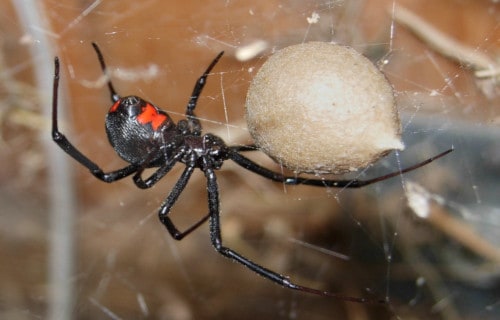
Black Widow Physical Description
Not surprisingly, the various species of Black Widow attain similar physical sizes. However, this remarkable arachnid typically displays a significant amount of sexual dimorphism. This physiological characteristic manifests itself in terms of both color patterns and size.
That’s partly because the female attains an average length of about 1.4 in (3.5 cm), whereas the male stays much smaller. He most commonly only reaches an average length of roughly 0.7 in (1.75 cm). The males also do not display the characteristic red hourglass.
Color patterns also vary relatively significantly between the various forms. All members of this genus, however, appear predominantly black in color. The females of each species, though, all display a very prominent red hourglass shape on their abdomens.
- Kingdom: Animalia
- Phylum: Arthropoda
- Class: Arachnida
- Order: Araneae
- Family: Theridiidae
- Genus: Latrodectus
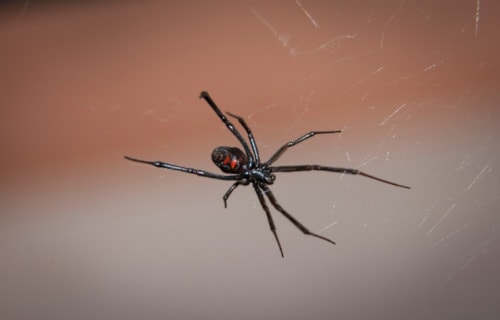
Black Widow Distribution, Habitat, and Ecology
The three species of Black Widow that evolved as native to North America remain the best known of the varieties. The incredible genus also thrives in many other areas of the world, though. In fact, the various species inhabit every continent of the world, except Antarctica.
Quite understandably, given its nearly global distribution, habitat types vary widely. Nevertheless, members of the genus most commonly live in temperate and tropical climates. A few of them, though, even live in extremely arid regions of the world.
Individuals usually build their webs in locations such as around rubble, small trees and bushes, in the wild. But, when found inside of human habitations, webs usually appear in isolated areas, such as attics and garages. This fortunately makes encounters rare.
When a human gets bitten, the venom of a Black Widow commonly causes a condition known as latrodectism. Experiences include profuse sweating, vomiting, muscle rigidity, and extreme pain. These symptoms typically persist for 3-6 days, but can last longer.
All currently known members of this genus hunt as ambush predators, laying in wait in the web. It feeds opportunistically, making a meal of any small creature caught in its web. Its diet, however, typically consists of mosquitoes, grasshoppers, beetles, and such.
Giant African Land Snail
Giant African Land Snail Facts
- Our next choice for inclusion in this gathering of these 4 Awesome Arthropods of Africa is the aptly-named Giant African Land Snail.
- This Gastropod most frequently, and appropriately, goes by the informative common name for obvious reasons. It’s also sometimes simply called the Giant African Snail. Intriguingly, though, it shares that general term with several other species.
- Scientific professionals, meanwhile, generally employ the formal name for the creature when referring to it. That term, however, remains somewhat hard to pronounce, as often happens. That’s because it bears the official name of Lissichatina fulica.
- It received that appellation as a result of the work of the respected French naturalist, Baron André Étienne Justin Pascal Joseph François d’Audebert de Férussac. He accomplished the first formal recognition of it as a separate and distinct species in 1821.
- This impressive invertebrate’s now been spread to many parts of the globe, outside of its natural range. That’s had the unfortunate result of making it an unwelcome fauna in some regions. In fact, it’s now listed as one of the top 100 invasive species in existence.
- The population of the Giant African Land Snail appears to be both stable and sufficient. This especially holds true in its native territory. Yet its numbers within introduced areas also remain impressive. The IUCN, therefore, currently has no Red List listing for it.
- Yet the now controversial creature does face some potential threats to its existence, if current trends continue. Habitat loss poses a possible future danger, understandably. Yet the greatest danger the animal faces likely consists of ongoing climate change.
Giant African Land Snail Physical Description
The Giant African Land Snail, the Lissachaina fulica, boasts some truly impressive physical statistics for a snail. In point of fact, all of the related species that also often go by the same name share very similar, though certainly not identical, attributes in that respect.
In a trait common to many shelled gastropods, this marvel of Nature evolved as hermaphroditic in nature. That means it has both male and female reproductive organs. The physiological characteristic of sexual dimorphism, therefore, does not apply in its case.
Mature adults of the species do tend to vary, sometimes significantly, in size, however. Yet some statistics remains firm. An average adult specimen attains an impressive body length of approximately 8 in (20 cm). These also reach an average diameter of roughly 4 in (10 cm).
That makes it one of the largest of all known land snails still in existence. Its awesomeness doesn’t end there, though. That’s because this creation of evolution reaches an average weight of roughly 1.13 oz (32 g). Apparent size varies, though, as the individual moves.
It also develops a highly intriguing shell. This simply adds to the appeal of the animal, to those who appreciate Nature. The protective structure develops in a strongly cone-shaped pattern. As a general principle, though, its height measures about twice the width.
The Giant African Land Snail has yet another impressive physical quality. That’s in the manner of its coloring. This varies quite widely, based on the surrounding environment. These include shades of dark brown, with stripes, or reddish-brown with yellow markings.
- Kingdom: Animalia
- Phylum: Mollusca
- Class: Gastropoda
- Order: Stylommatophora
- Family: Achatinidae
- Genus: Lissachatina
- Species: L. fulica
Giant African Land Snail Distribution, Habitat, and Ecology
The very name of the Giant African Land Snail provides a clear indication of its natural range of distribution. That’s due to the fact that, as implied by that term, it natively inhabits portions of the continent of Africa. It does not appear naturally in all areas, though.
To be more precise, the invertebrate originally evolved as endemic to only the coastal regions and islands of East Africa. Now, however, the intrepid creature has expanded its range, partly due to the actions of humans, into other portions of the continent.
The snail principally appears from Mozambique, in the south, to Somalia and Kenya in the north, though. The mollusc also evolved as highly adaptable in terms of its habitat requirements. In its native range, it mainly lives in regions possessing tropical-like climates.
Outside of that primary zone of habitation, however, it’s now adapted to numerous temperate climates around the globe. This frequently includes such diverse ecosystems as forests, coastal regions, wetlands, disturbed areas, agricultural zones, and urban areas.
This marvelous gastropod, like its related species, evolved as fully herbivorous in nature. In its case, though, its diet covers a wide range of flora. This includes various vegetables and fruit, fungi and lichens. Yet it also sometimes consumes cardboard and paper!
Being hermaphrodites, reproduction remains somewhat different for the Giant African Land Snail. Individuals do not self-fertilize, as one might expect. Instead, each individual mates with another, with each fulfilling a different gender role from one mating to another.
Brown Widow
Brown Widow Facts
- The final entry into this compilation of 4 Awesome Arthropods of Africa is the impressive work of Nature bearing the moniker of the Brown Widow.
- The term we’re using herein serves as only one of many common names for this lesser-known cousin of the dreaded Black Widow. Some of the others, though, include such terms as the grey widow, brown button spider, and brown black widow.
- The scientific name, however, for this remarkable arachnid remains that of the tongue-twisting Latrodectus geometricus. By either of these many names, though, it remains a significantly less dangerous species than its much better known relative.
- The first official recognition of this fascinating spider as a separate and distinct species occurred in the year 1841. This impressive work also took place as the result of the efforts of the well respected German entomologist, Carl Ludwing Koch.
- Due to a combination of its territorial range and numbers, it appears to be maintaining a stable population base. The IUCN, therefore, currently has no listing for the creature. Such a listing would appear on the organization’s Red List.
- The amazing Brown Widow Spider, should, however, still be considered to facing various risks. These further include such dangers as habitat loss across its range. Its greatest threat, though, likely comes in the form of ongoing climate change.
Brown Widow Spider Physical Description
Not surprisingly, given the similarity in names, as well as the genetic relationship, the Brown Widow Spider bears a resemblance to the Black Widow. Various physical differences quite obviously do exist, however, between the two species of arachnid.
Among these differences remains the simple fact that in this species, the degree of sexual dimorphism remains far more pronounced. That characteristic manifests itself in the fact that females attain a significantly larger size than do the males of the species.
More precisely, the smaller male attains an average body length of no more than 0.08 – 0.16 in (2 – 4 mm). The larger female, meanwhile averages reaching a body length of between 0.28 – 0.4 in (7 -1 0 mm). In both genders, the legs develop as highly elongated.
In coloring, the male Brown Widow Spider also tends to be more consistent in coloring. His body typically displays various shades of brown. The female, though, varies sharply among individuals, including shades of gray, white, light and dark brown, and nearly black.
The legs of the female also generally develop a dense covering of fine white hairs. The smaller, drabber male, though, does not possess this trait. Females of this remarkable species also display the same hourglass shape on their abdomens as their cousins.
- Kingdom: Animalia
- Phylum: Arthropoda
- Class: Arachnida
- Order: Araneae
- Family: Theridiidae
- Genus: Latrodectus
- Species: L. geometricus
Brown Widow Spider Distribution, Habitat, and Ecology
The amazing Brown Widow Spider actually inhabits an extremely broad swathe of the world. In point of fact, the arthropod currently inhabits a truly cosmopolitan area. Evidence indicates, though, that this occurs due to an artificial expansion via the actions of man.
Unfortunately, this has rendered it almost impossible to determine the area of the world in which it originally evolved. Nevertheless, recent evidence seems to indicate that this marvelous arthropod originally appeared in the area what’s now South Africa, in Africa.
In the wild, this invertebrate inhabits nearly all temperate and tropical environments. It has also completely adapted to inhabiting areas in and around human structures. These include the outsides of garages, picnic tables, along fences, and even piles of debris.
Like other spiders, the Brown Widow Spider evolved as a pure carnivore. It feeds on a wide variety of small insects, consuming virtually anything small enough to become trapped in its web. This it constructs with a random, often haphazard structure, like some species.
After mating, the female lays between 120 – 150 eggs in a sac. This structure has a distinct shape, being covered with numerous spiny projections. All specimens of this arthropod possess venom, yet this remains much less dangerous to humans the the Black Widow.

4 Awesome Arthropods of Africa
We hope that each of you, our readers, will enjoy and appreciate this article we present about these 4 Awesome Arthropods of Africa. It was certainly our pleasure to compile the information for you. May it provide you with both education and increased awareness.
These few species listed herein represent only a portion of the natural wonders found throughout the region, though. Yet, it’s our belief that they serve as excellent representations of the wonders found here. Check out some of our other articles for similar marvels.
Check out our other articles on 4 Magical European Moths, The Mighty Tornado, 3 Amazing North American Amphibians, Wonderful Wild Cats of the World
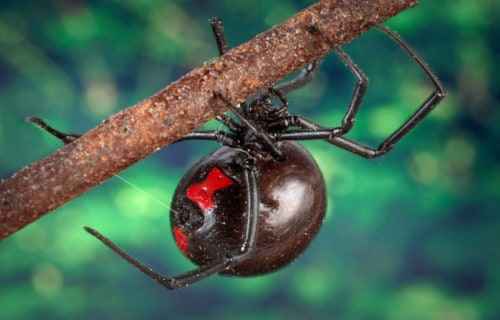
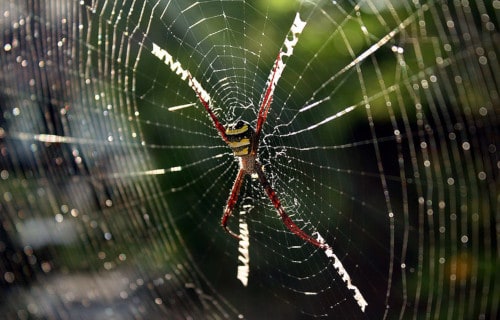
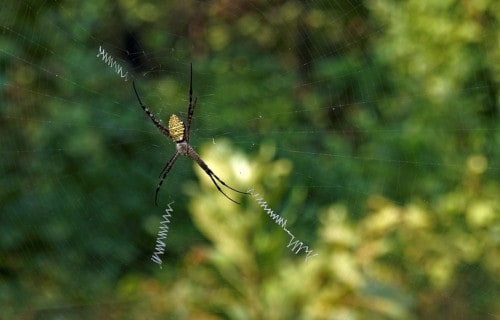
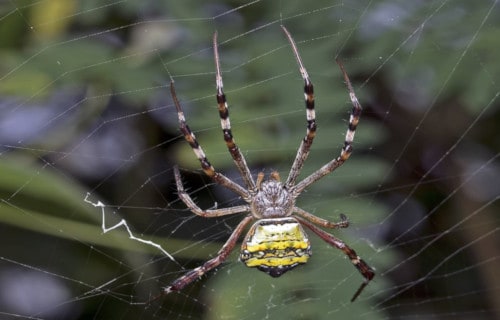
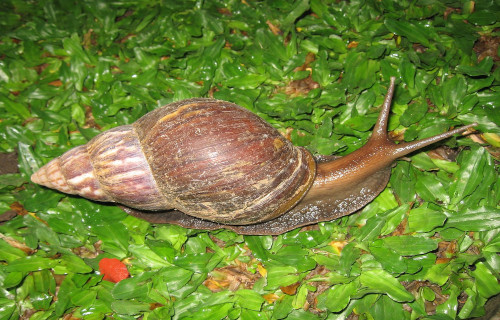
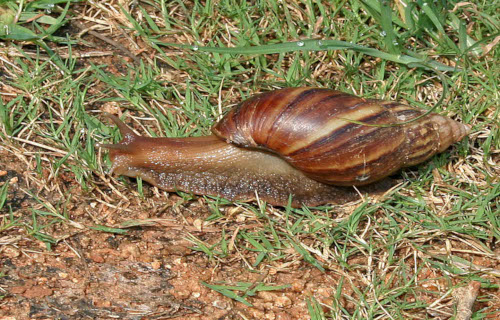
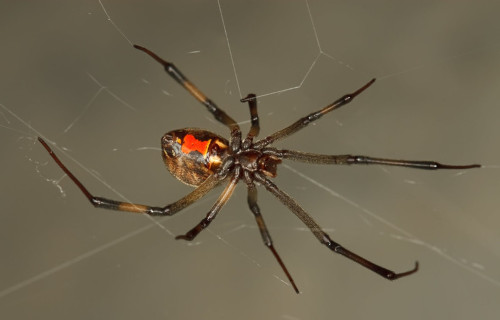
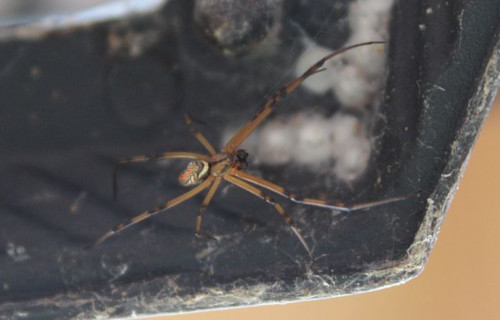
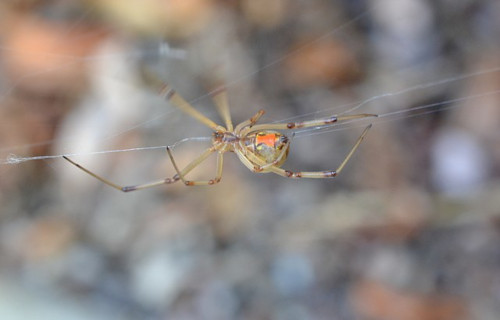









Leave a Reply